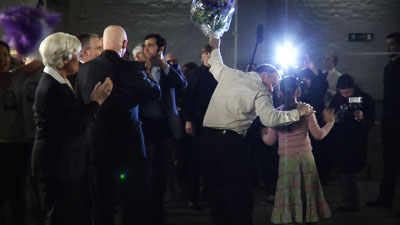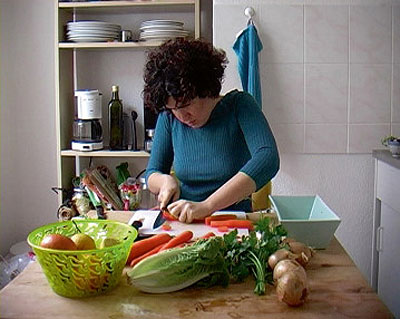
Courtesy Clemens von Wedemeyer
Freisteller
Villa Romana - Preisträger 2008
Dani Gal » Asli Sungu » Clemens von Wedemeyer »
Exhibition: 26 Apr – 22 Jun 2008

Courtesy Dani Gal
For the first time, the Deutsche Guggenheim in Berlin will introduce the recipients of the Villa Romana Fellowship. The exhibition will feature new paintings, installations, and videos by Dani Gal, Julia Schmidt, Aslı Sungu, and Clemens von Wedemeyer. The Villa Romana Fellowship, awarded to exceptional young talent since 1905, includes a stipend and a residency program, allowing fellows to live and work for ten months in the artists' house in Florence. This art prize is not just the oldest in Germany; it also represents Deutsche Bank's longest cultural commitment. The presentation at the Deutsche Guggenheim marks a new mile stone in the bank's partnership with the arts, while also continuing the series of exhibitions conceived by Deutsche Bank within its joint venture with the Solomon R. Guggenheim Foundation. Freisteller was curated by Angelika Stepken, Director of the Villa Romana. The fellows were selected by the Berlin artist Ayse Erkmen and the Leipzig art historian Beatrice von Bismarck. The German term "Freisteller," used in photography, printing and computer graphics, describes an image that is cut out from its background and context in order to insert it into a new composition. Freisteller is also the title of the current exhibition at the Deutsche Guggenheim that will introduce the Villa Romana Fellows - four young artists with diverse biographies and backgrounds working in various media. At first glance, Dani Gal, Julia Schmidt, Aslı Sungu, and Clemens von Wedemeyer seem to have only two things in common: they live and work in Germany, and they will now spend time together in a new cultural and geographical environment - as residents of the renowned artists' house in the hills of Florence. Yet, as the exhibition title suggests, the selected artists share a number of common interests and strategies, specifically in the field of photography. They disconnect motifs and themes from their original context and, through this process of "cutting out," open up new discursive relationships. Dani Gal combines influences from popular culture with historical research; Julia Schmidt works with found images from magazines and the Internet, which she fragments and isolates in her paintings; Aslı Sungu's videos explore everyday activities to show how our conception of identity, and of "right" or "wrong" are socially determined; and Clemens von Wedemeyer's films fuse elements of political documentation with fiction to expose the interplay between concrete social situations and media representation. The organization of the exhibition space as well departs from the hermetic, protective structure of the white cube. The window facade of the Deutsche Guggenheim is opened up, while partition walls and platforms serve as display units for the artworks. Encountered within this temporary exhibition design, the presented works achieve a dual purpose: they offer insights into the creative practice of each of the recipients, and they address a broad spectrum of questions raised by contemporary art - media and institutional critique, migration, and the ability to articulate critical and political viewpoints. The exhibition Freisteller documents how an institution like the Villa Romana, rich in tradition and far from the great metropolitan centers, can succeed in becoming a creative think tank of contemporary art and a place for intercultural exchange. Equally notable is the fact that the Villa Romana Fellows are now, for the first time, being presented at the Deutsche Guggenheim. The affiliation between both institutions establishes a public forum that is capable of authentically reflecting the vital, internationally-oriented art scene in Germany.
Zum ersten Mal stellt das Deutsche Guggenheim in Berlin die aktuellen Villa Romana-Preisträger vor: Zu sehen sind neue Bilder, Installationen und Videos von Dani Gal, Julia Schmidt, Aslı Sungu, und Clemens von Wedemeyer. Seit 1905 wird der Villa Romana-Preis an herausragende junge Künstler verliehen. Sie erhalten ein Stipendium und beziehen für zehn Monate ein Wohn-Atelier in dem Florentiner Künstlerhaus. Die Auszeichnung ist nicht nur der älteste deutsche Kunstpreis, sondern auch das am längsten bestehende kulturelle Engagement der Deutschen Bank. Mit der Schau im Deutsche Guggenheim findet diese Kooperation einen neuen Höhepunkt und setzt zudem die Reihe der von der Bank konzipierten Ausstellungen in dem Joint Venture mit der Solomon R. Guggenheim-Stiftung fort. Kuratiert wurde Freisteller von Angelika Stepken, der Leiterin der Villa Romana. Die Auswahl der Preisträger trafen die in Berlin lebende Künstlerin Ayse Erkmen und die Leipziger Kunstwissenschaftlerin Beatrice von Bismarck. Der Begriff "Freisteller" bezeichnet in der Fotografie, Drucktechnik und Computergrafik ein Motiv, das vom Hintergrund und seinem Kontext gelöst wird und so u.a. in andere Bildzusammenhänge eingefügt werden kann. Freisteller ist auch der Titel der aktuellen Ausstellung im Deutsche Guggenheim, die die Villa Romana- Preisträger 2008 vorstellt - vier junge Künstler, die unterschiedliche Medien nutzen, unterschiedliche Biographien und Nationalitäten haben. Auf den ersten Blick vereint Dani Gal, Julia Schmidt, Aslı Sungu und Clemens von Wedemeyer lediglich, daß sie in Deutschland leben und arbeiten und nun gemeinsam - im neuen kulturellen und geografischen Kontext - ein Stipendium in dem renommierten Künstlerhaus auf den Hügeln über Florenz verbringen. Zugleich verweist der Ausstellungstitel aber auf verbindende Interessen und Strategien der Preisträger. Alle beteiligten Künstler lösen ihre Motive und Themen aus dem ursprünglichen Kontext, "stellen sie frei" und erschließen so neue, diskursive Zusammenhänge. Dani Gal verbindet Einflüsse der Populärkultur mit historischer Recherche, Julia Schmidt arbeitet mit vorgefundenen Bildern aus Magazinen oder dem Internet, die sie auf ihren Gemälden isoliert und fragmentarisiert. Aslı Sungu untersucht in ihren Videos alltägliche Handlungen, um aufzuzeigen, wie unsere Vorstellungen von Identität, von "Richtig" und "Falsch" gesellschaftlich determiniert sind. In seinen Filmen verbindet Clemens von Wedemeyer Elemente der politischen Dokumentation mit Fiktion, und macht so die Wechselwirkungen zwischen realen gesellschaftlichen Situationen und medialer Darstellung sichtbar. Dementsprechend bricht auch das räumliche Konzept der Schau mit der hermetischen und schützenden Struktur des White Cube. Die Fensterfront des Deutsche Guggenheim wird frei gelegt, während in die Halle hinein gebaute Stellwände und Plattformen die Funktion von "Platzhaltern" für die Kunst übernehmen. In dieser temporären Ausstellungsarchitektur geben die vorgestellten Positionen zugleich einen Einblick in das individuelle Schaffen der Preisträger und eröffnen exemplarisch ein breites Spektrum an Fragen, die heute in der aktuellen Kunst verhandelt werden: Medien- und Institutionskritik, Migration, die Möglichkeiten, kritische und politische Haltungen zu formulieren. Die Ausstellung Freisteller dokumentiert, wie sich die traditionsreiche Institution Villa Romana abseits der großen Metropolen als kreativer Think Tank der Gegenwartskunst und Ort des interkulturellen Austauschs profiliert. Daß die Preisträger der Villa Romana nun erstmals im Deutsche Guggenheim präsentiert werden, setzt Zeichen. Denn durch die Vernetzung beider Häuser wird ein öffentlichkeitswirksames Forum geschaffen, das die vitale, international agierende Szene in Deutschland authentisch widerspiegelt.

Courtesy Asli Sungu